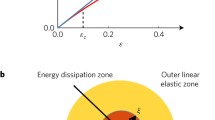Abstract
For a growing crack the conventional definitions of tilting and twisting are inadequate. New definitions are proposed, based on differential geometry, and it is shown that, in homogeneous, isotropic, brittle solids, non-planar crack growth must occur entirely by tilting movements. Examples are given of the growth of cracks on curved surfaces which illustrate that the no-twist condition produces significant constraints on the path of fracture. The development of fracture surfaces when cracks are subject to mixed-mode loading conditions are described with particular reference to the influence of mode III, twisting conditions. It is shown that the requirement that only tilting can occur leads to many characteristic fractographic features.
Similar content being viewed by others
References
W.B. Bradley and A.S. Kobayashi, Experimental Mechanics 10 (1970) 106–113.
A.S. Kobayashi and B.G. Wade, in Deformation and Fracture of High Polymers, H.H. Kausch et al. (eds), Plenum Press (1973) 487–500.
M.F. Kanninen, A.R. Rosenfield and R.G. Hoagland, in Deformation and Fracture of High Polymers, H.H. Kausch et (eds), Plenum Press (1973) 471–486.
K. Ravi-Chandar and W.G. Knauss, International Journal of Fracture 25 (1984) 247–262.
K. Ravi-Chandar and W.G. Knauss, International Journal of Fracture 26 (1984) 65–80.
K. Ravi-Chandar and W.G. Knauss, International Journal of Fracture 25 (1984) 141–154.
K. Ravi-Chandar and W.G. Knauss, International Journal of Fracture 25 (1984) 189–200.
J.W. Dally, W.L. Fourney and G.R. Irwin, International Journal of Fracture 27 (1985) 159–168.
T.M. Maccagno and J.F. Knott Engineering Fracture Mechanics 34 (1989) 65–86.
A.A. Rubinstein, International Journal of Fracture 47 (1991) 291–305.
K. Arakawa and K. Takahashi, International Journal of Fracture 48 (1991) 103–114.
N.A. Fleck, Proceedings of Royal Society London A 432 (1991) 55–76.
P.A. Wawrzynek and A.R. Ingraffea, Theoretical Applied Fracture Mechanics 8 (1987) 137–150.
P. Bocca, A. Carpenteri and S. Valente, International Journal of Solid Structures 27 (1991) 1139–1153.
C.de Freminville, Revue de Metallurgie 11 (1914) 971–1056.
F.W. Preston, Journal of American Ceramic Society 14 (1931) 419–427.
J.B. Murgatroyd, Journal of Society of Glass Technology 26 (1942) 155–171.
E.F. Poncelet, Journal of Society of Glass Technology 42 (1958) 279–298.
D. Purslow, Composites 17 (1986) 289–303.
B.R. Lawn and T.R. Wilshaw, Fracture of Brittle Solids, Cambridge University Press, Cambridge (1975).
F. Kerkhof, in Proceedings of an International Conference on Dynamic Crack Propagation, G.C. Sih (ed.), Noordhoff International Publishing (1972) 3–35.
K. Takahashi and K. Arakawa, Experimental Mechanics 27 (1987) 195–200.
K. Peter, (see [21]).
F. Erdogan and G.C. Sih, Journal of Basic Engineering 85 (1963) 519–527.
K. Palaniswamy and W.G. Knauss, in Mechanics Today, S. Nemat-Nasser (ed.), Pergamon Press (1978) 87–148.
G.C. Sih, International Journal of Fracture 10 (1974) 305–321.
M.M. Frocht, Photoelasticity, Vol. 1, Wiley, New York (1941).
B.R. Lawn, T.R. Wilshaw and N.E.W. Hartley, International Journal of Fracture 10 (1974) 1–16.
J.P.A. Tillett, Proceedings Physical Society B 69 (1956) 47–54.
S. Tolansky and V.R. Howes, Proceedings Physical Society B 67 (1954) 467–472.
W.G. Knauss, International Journal of Fracture 6 (1970) 183–187.
E. Sommer, Engineering Fracture Mechanics 1 (1969) 539–546.
A. Smekal, Oesterreichisches Ingenieur Archiv 7 (1953) 49–70.
Author information
Authors and Affiliations
Rights and permissions
About this article
Cite this article
Hull, D. Tilting cracks: the evolution of fracture surface topology in brittle solids. Int J Fract 62, 119–138 (1993). https://doi.org/10.1007/BF00035157
Received:
Accepted:
Issue Date:
DOI: https://doi.org/10.1007/BF00035157




